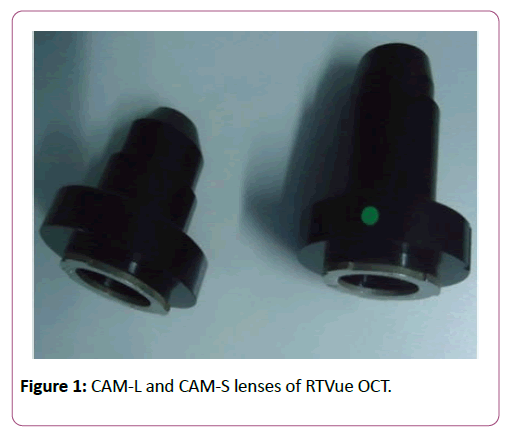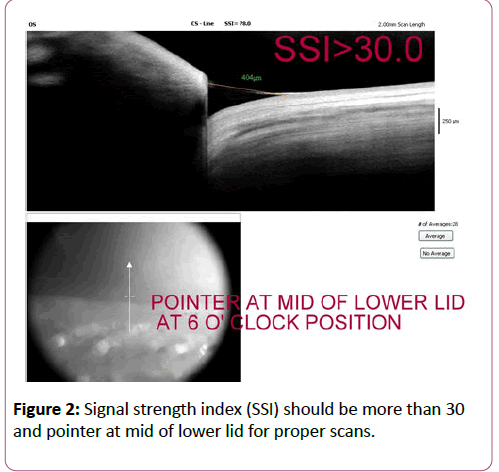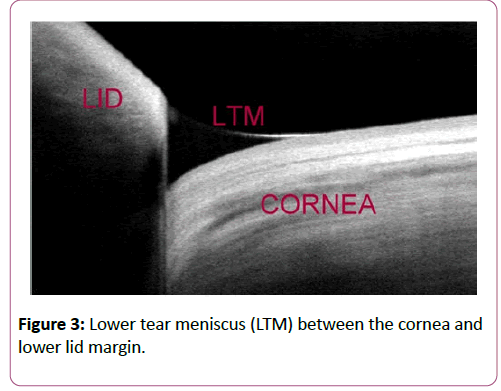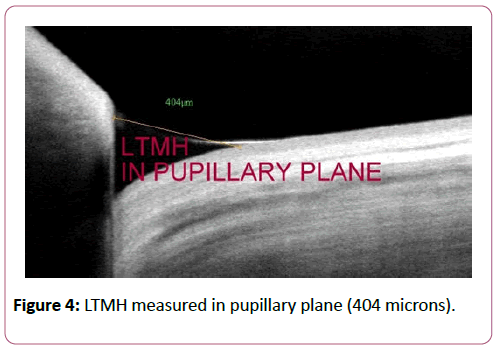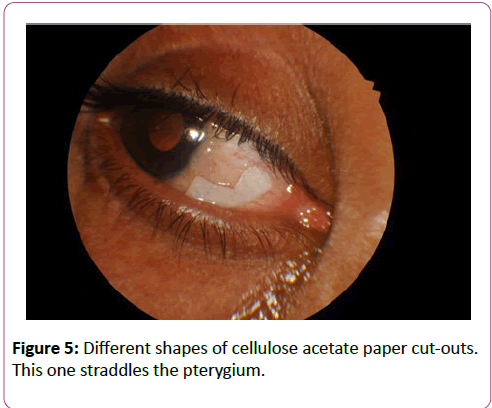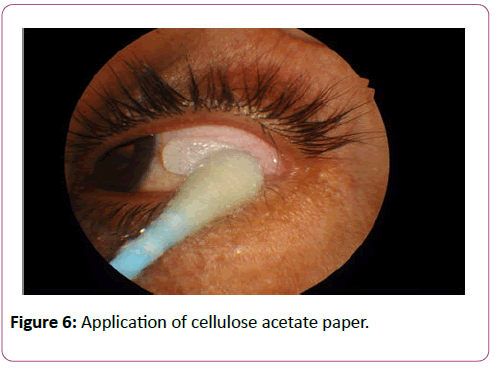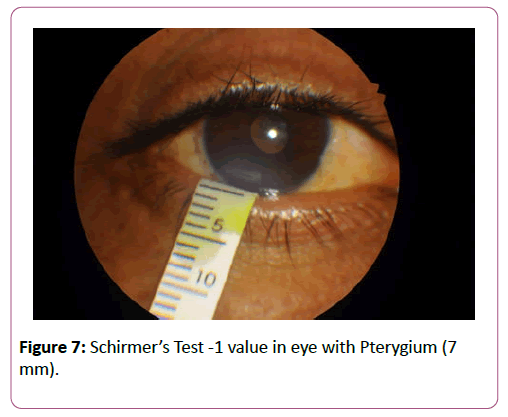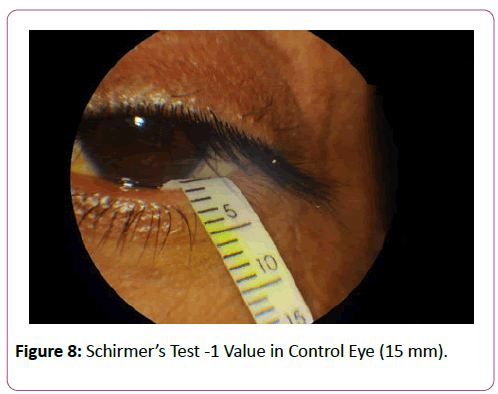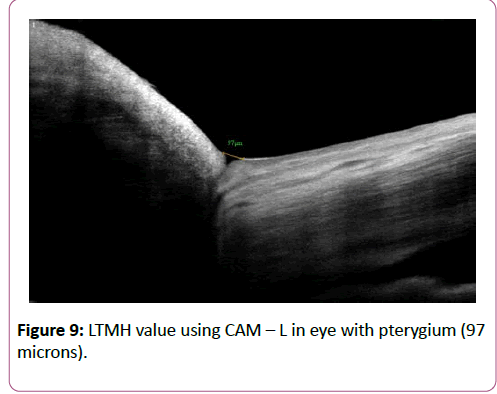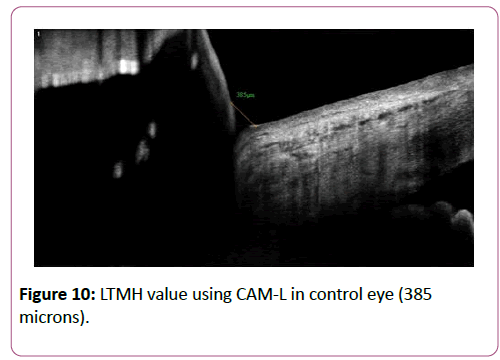Keywords
Pterygium; Optical coherence tomography; Tear break-up time; Schirmer
Keymessage
This study emphasizes that tear film abnormalities play a role in aetiology of pterygium and hence early institution of therapy for tear film stabilization can help prevent the disease.
Introduction
Pterygium remains an oblivious dilemma except for its unanimously accepted description as a triangular, fibro-vascular sub-epithelial in-growth of degenerative conjunctival tissue encroaching onto the cornea. Although environmental factors appear to be the dominant cause, tear film abnormalities are also incriminated in its theories of aetiopathogenesis [1-7].
Pterygium has preponderance in Agra with prevalence varying between 15-20 %. Agra features a semi-arid, subtropical climate, providing ideal conditions for studying tear film abnormalities in pterygium. Pterygium justifies the adage “prevention is better than cure” and it becomes pertinent that we evaluate the status of tear film so as to find effective, documentable, time-efficient, and preferably non-invasive tools for detecting early tear film abnormalities and suggest remedial measures [8].
The aforesaid study has been conducted with the following aims and objectives:
• To evaluate tear film qualitatively and quantitatively so as to deduce statistical correlation between tear film abnormalities and pterygium.
• To adjudge useful tools for tear film evaluation in pterygium.
Subjects and Methods
Patients for this study were selected from among those attending the ophthalmology OPD and also from the eye clinics conducted by the patient outreach mobile camp units of the department.
Time Frame: March 2011 to December 2012.
Study Design: Cross-sectional, case-control, double - blinded study.
Selection of Cases
One hundred and two (102) cases of unilateral pterygium were studied. The other eye of the patient, if devoid of pterygium, acted as control. Every selected patient was examined, investigated and statistical data analysis was done in a double-blinded manner. Chi-square test was applied and p-value <0.05 was considered significant.
Patients were evaluated as per the following format
• Identification of patient- age, sex, address and occupation.
• History
• General examination
• Ocular examination
• Uncorrected and Corrected Visual acuity
• Slit lamp examination
• Pre-defined tests for tear evaluation-
• Schirmer’s test-I
• Tear meniscus height (TMH)
• Rose Bengal staining (RBS)
• Tear break up time (TBUT)
• Optical coherence tomography (OCT)
• Conjunctival impression cytology
Inclusion criteria
• Pterygium with extension onto the cornea beyond the limbus
• Both male and female
• Age range 28-76 years
• Consenting to participate
• Unilateral pterygium
• All grades of pterygium
Exclusion criteria
• Bilateral pterygium
• Active inflammation in either eye at presentation
• Recurrent pterygium
• History of ocular surgery, trauma or corneo-limbal scar
• Blepharitis, lacrimal system disorders at presentation
• Pre-diagnosed cases of dry eye
• Pseudo-pterygium or signs of malignancy on pterygium
• Patients on topical medications
Methodology of the pre-defined tests
Schirmer’s test: Sterilized Schirmer’s strip of the size 5 x 35 m was used. It was placed at the junction of outer 1/3 and medial 2/3 of lower lid in the fornix. More than 15 mm wetting/5 min. was considered normal and lesser values were considered abnormal [9].
Rose Bengal staining: Staining of inferior bulbar conjunctiva was done by dabbing the colored end of moistened rose Bengal strip on it. Under the slit-lamp, diffuse white light illumination was used to scan the cornea and bulbar conjunctiva for rosy-red areas of dye uptake which indicate intact but devitalized epithelial cells. It was performed before Schirmer’s test to avoid false positive staining. Van Bijsterveld scoring system was used to quantify the staining as normal or abnormal [10].
Tear meniscus height (TMH): The patient was examined under the slit-lamp bio microscopy. Tear meniscus height of more than 0.3 mm was considered normal. Values below this level were considered abnormal.
Tear break-up time (TBUT): Fluorescein strip was used for staining by touching the inferior fornix and making the patient blink several times. The cornea was scanned under low magnification of the slit-lamp using the cobalt-blue filtered light. Time of appearance of first black spot within the blue-green field from last blink measures the tear film BUT. Values more than 10 seconds were considered normal [11].
Optical coherence tomography (OCT): RTVue (Optovue corporation, Fremont, CA, USA) spectral domain OCT with Cornea-anterior module (CAM) attachment was used for tear meniscus evaluation. Two different types of CAM lenses are used for this purpose. CAM – L (Long) lens uses 6mm vertical beam and scans wider field while CAM-S (Short) lens uses 2 mm vertical beam thus giving higher magnification (Figure 1).
Figure 1: CAM-L and CAM-S lenses of RTVue OCT.
The pointer is positioned at middle of lower lid margin at 6 o’clock. Patient was asked to blink and then see vertically upwards. Scans were taken within a few seconds of blink with measurements taken in the pupillary plane. Signal strength index (SSI) should be more than 30 for ideal scans (Figures 2, 3 and 4) [12,13]. Values between both eyes were compared and tests of significance were applied to find out any difference in values between the two lenses.
Figure 2: Signal strength index (SSI) should be more than 30 and pointer at mid of lower lid for proper scans.
Figure 3: Lower tear meniscus (LTM) between the cornea and lower lid margin.
Figure 4: LTMH measured in pupillary plane (404 microns).
Conjunctival impression cytology (CIC): Conjunctival impression was obtained using cellulose acetate paper strips. The eyes were topically anaesthetized with 4% xylocaine drops. A blunt smooth edged forceps used to grasp the filter paper strip and the paper applied on the temporal bulbar conjunctiva (Figures 5 and 6). The paper strip was removed with a peeling motion after 2-3 seconds. The strips dropped into a bottle containing the fixative solution (ethyl alcohol, formaldehyde and glacial acetic acid in 20:1:1 volume ratio) and transferred to the pathology laboratory [14]. Grading of Squamous metaplasia and goblet cell density was done according to Nelson’s classification and graded as normal or abnormal [15].
Figure 5: Different shapes of cellulose acetate paper cut-outs. This one straddles the pterygium.
Figure 6: Application of cellulose acetate paper.
Results
This study was conducted in our department on 102 (70 males/32 females) cases of unilateral pterygium attending the out-patient department or presenting to the out-reach team visiting the suburban areas of Agra.
Age-sex distribution
Average age of the study group was 48.78 years with age range of 28-76 years. In this study, 8.8% cases belonged to 20-30 age group, 21.6% were in 30-40 age range, 41.2% in 40-50 years, 19.6% in 50-60 years, 4.9% in 60-70 years and 3.0039% in more than 70 years age group respectively (Table 1). Maximum number of cases was seen in the 40-50 year age group in both sexes (41.2%). Pterygium was more common in males than females in this study (male/female=2.2).
| Age range |
Males |
Females |
Total |
| (years) |
(n=70) |
(n=32) |
(n=102) |
| |
Number |
Number |
Number |
| 20-30 |
7 |
2 |
9 |
| 30-40 |
16 |
6 |
22 |
| 40-50 |
28 |
14 |
42 |
| 50-60 |
12 |
8 |
20 |
| 60-70 |
4 |
1 |
5 |
| 70+ |
3 |
1 |
4 |
Table 1: Age-sex distribution of the study population.
Occupation
Incidence of pterygium was found to be higher in people involved in outdoor activities (80.4%) (Table 2).
| Activity |
Males |
Females |
Total |
| (n = 70) |
(n = 32) |
(n = 102) |
| Number |
Percent |
Number |
Percent |
Number |
Percentage |
| Outdoor |
58 |
82.8 |
24 |
75 |
82 |
80.4 |
| Indoor |
12 |
17.2 |
8 |
25 |
20 |
19.6 |
| Total |
70 |
100 |
32 |
100 |
102 |
100 |
Table 2: Occupation-wise distribution of the study population.
Location of pterygium
In this study, 71.6% (73/102) of the pterygium was located on the nasal side, 20.6% (21/102) on the temporal side and 7.8% (8/102) had double pterygium.
Fluorescein tear meniscus height results
Tear film height measurements on slit-lamp evaluation in eyes with pterygium and control eyes were found to be normal in 74.5% and 88.2%, while it was abnormal in 25.5% and 11.8% respectively. This was statistically significant (p=0.019) with Chisquared value of 5.465 (Table 3).
| Test value |
Eyes with pterygium (n=102) |
Control eyes (n=102) |
| (mm) |
Number |
Percentage |
Number |
Percentage |
| Normal |
76 |
74.5 |
90 |
88.2 |
| (> 0.3 mm) |
| Abnormal |
26 |
25.5 |
12 |
11.8 |
| (<0.3 mm) |
| (p=0.019) with Chi-squared value of 5.465 |
Table 3: Fluorescein tear film height test results in the study population.
Schirmer’s test-1 results
The mean Schirmer’s test value in normal control eyes was 13.4 ± 2.5 mm.The comparable value in eyes with pterygium was 9.2 ± 2.4 mm (Figures 7 and 8). The values were normal, low normal and borderline in 52.9%, 27.5% and 19.6% of eyes with pterygium and in 70.6%, 25.5% and 3.9% of control eyes respectively. This was statistically significant (p=0.014) with Chi-squared value of 5.999 (Table 4).
| Schirmer’s test-1 values (mm) |
Eyes with pterygium (n=102) |
Control eyes (n=102) |
| |
Number |
Percentage |
Number |
Percentage |
| Normal |
54 |
52.9 |
72 |
70.6 |
| (> 15 mm) |
| Low normal |
28 |
27.5 |
26 |
25.5 |
| (10-15 mm) |
| Borderline |
20 |
19.6 |
4 |
3.9 |
| (5-10 mm) |
| Abnormal |
0 |
0 |
0 |
0 |
| (< 5 mm) |
| (p=0.014) with Chi-squared value of 5.999. |
Table 4: Schirmer’s test-1 results in the study population.
Figure 7: Schirmer’s Test -1 value in eye with Pterygium (7 mm).
Figure 8: Schirmer’s Test -1 Value in Control Eye (15 mm).
Rose Bengal staining test results
Staining was found to be normal in 80% and abnormal in 20% of eyes with pterygium and 93% and 7% of control eyes respectively. This was significantly low in eyes with pterygium (p=0.013; chi-squared=6.147) (Table 5).
| RBS staining |
Eyes with pterygium |
Control eyes |
| (n=102) |
(n=102) |
| Normal |
82 |
95 |
| Abnormal |
20 |
7 |
| (p = 0.013; chi-squared=6.147) |
Table 5: Rose Bengal staining test results in the study population.
Tear break-up time test results
The mean TBUT value in the normal control eyes was 12.3 ± 1.9 sec. The mean value in eyes with pterygium was 8.2 ± 1.4 sec.
It was normal in 62.7% and abnormal in 37.3% of eyes with pterygium and 82.3% and 17.7% of control eyes respectively. This was significantly low in eyes with pterygium (p=0.001; chi squared = 8.886) (Table 6).
| T-BUT |
Eyes with pterygium (n=102) |
Control eyes |
| test value |
(n=102) |
| (seconds) |
Number |
Percentage |
Number |
Percentage |
| Normal |
64 |
62.7 |
84 |
82.3 |
| (> 10 s) |
| Abnormal |
38 |
37.3 |
18 |
17.7 |
| (<10s) |
| (p value = 0.001; chi squared = 8.886). |
Table 6: Tear break-up time test results in the study population.
OCT CAM-L LTMH results
In this study, mean OCT CAM-L LTMH values obtained were 0.325 ± 0.088 mm in control eyes and 0.204 ± 0.058 mm in pterygium (Figures 9 and 10).
Figure 9: LTMH value using CAM – L in eye with pterygium (97 microns).
Figure 10: LTMH value using CAM-L in control eye (385 microns).
It was abnormal in 92.2% and normal in 7.8% of pterygium eyes and 39.2% and 60.8% of control eyes respectively. This was statistically significant (p<0.001) with Chi-squared value of 61.091 (Table 7).
LTMH Value
(microns) |
Eyes with pterygium (n=102) |
Control eyes (n=102) |
| |
| |
Number |
Percentage |
Number |
Percentage |
| Normal |
8 |
7.8 |
62 |
60.8 |
| (> 300 µ) |
| Abnormal |
94 |
92.2 |
40 |
39.2 |
| (< 300 µ) |
| (p<0.001) with Chi-squared value of 63.45 |
Table 7: OCT CAM-L LTMH values in the study population.
OCT CAM-S LTMH results
In this study, mean OCT CAM-S LTMH values obtained were 0.338 ± 0.082 mm in control eyes and 0.212 ± 0.046 mm in pterygium.
It was abnormal in 90.2% and normal in 9.8% of eyes with pterygium and 35.3% and 64.7% of control eyes respectively. This was statistically significant (p<0.001) with Chi-squared value of 63.45 (Table 8).
| LTMH Value (microns) |
Eyes with pterygium (n=102) |
Control eyes (n=102) |
| |
Number |
Percentage |
Number |
Percentage |
| Normal |
10 |
9.8 |
66 |
64.7 |
| (> 300 µ) |
| Abnormal |
92 |
90.2 |
36 |
35.3 |
| (< 300 µ) |
| (p<0.001) with Chi-squared value of 63.45 |
Table 8: OCT CAM-S LTMH values in study population.
CAM-L versus CAM-S LTMH
There was no significant difference between the LTMH values procured with CAM-L and CAM-S. The Chi-squared value was 0.061 and p value was 0.805 in eyes with pterygium and 0.193 and 0.67 in control eyes respectively. Hence either of CAM-L or CAM-S can be used effectively for LTMH evaluation.
Conjuctival smear cytology results
Conjunctival smear cytology results in the eyes with pterygium demonstrated no changes in 52.9%, grade 1 changes in 35.3%, grade 2 changes in 11.8% while control eyes had no changes in 78.4% and grade 1 changes in 21.6%. Abnormal impression cytology was obtained in 47.1% of eyes bearing pterygium and 21.6% of control eyes. This was statistically significant (p<0.001) with Chi squared value of 13.593 (Table 9).
| Grade |
Grade 0 |
Grade 1 |
Grade 2 |
Grade 3 |
Total Abnormal |
| Eyes with |
54 |
36 |
12 |
0 |
48 |
| pterygium |
| (n= 102) |
| Control eyes |
80 |
22 |
0 |
0 |
22 |
| (n= 102) |
| Total |
134 |
58 |
12 |
0 |
70 |
| (p<0.001) with Chi squared value of 13.593 |
Table 9: Conjunctival impression cytology results in the study population.
Discussion
Pterygium, even after thousands of years since its recognition, still maintains its status as an ‘ophthalmic enigma’. Numerous theories have been proposed without any unanimous consensus. In this cross-sectional study conducted at our department between March 2011 and April 2012, relation between tear film abnormalities and its association with pterygium was studied.
Age incidence
Earlier studies conducted by Cameron (1965), Youngson (1970) indicated that pterygium was more common in people beyond 40 years of age. In the Indian scenario, a study by Rao et al. concluded that around 60% cases were seen in fourth decade [14-16]. In this study, we conclude that maximum prevalence of pterygium was seen in the fourth decade (41.2%). A slightly lower value than earlier studies could be because of the fact that only unilateral pterygium was included in this study.
Sex incidence
A universal conclusion from all the studies conducted in India and abroad is that pterygium is seen more commonly in males than females [17-20]. In our study, 68 males and 32 females had pterygium giving a male/female ratio of approximately 2.2.
Occupation incidence
In our study, 80% of the cases were involved in outdoor activities, corroborating with the earlier studies [19,20].
Location of pterygium
In our study nasal location of pterygium was seen in 71.6% of the cases conforming to other studies as that by Sangwan et al. [18].
Schirmer’s test – 1 results
Reports regarding abnormal Schirmer’s values in pterygium have been conflicting. While studies by Gazzard et al. and Rahman et al. suggest no significant relationship between the two, other studies like that of Goldberg et al., Pandey et al., and Chaidaroon et al. showed significant decrease in Schirmer’s test values in pterygium [21-24]. In our study, Schirmer’s test values were found to be significantly lower when compared with the values in control eyes (p=0.014).
Rose Bengal staining test results
It was found to be significantly reduced in eyes with pterygium (p=0.013), conforming to the results of aforesaid studies [21-24].
Tear break-up time test results
Unlike the dubious results associated with Schirmer’s test results in the various studies, results of TBUT have shown abnormal values in almost all the previous studies [21-24]. In our study, TBUT values were found to be significantly reduced in eyes with pterygium as compared to the control eyes (p=0.002).
OCT CAM – L and CAM-S Values
Lower tear meniscus height (LTMH) measured with OCT CAM-L and CAM-L lens was found to be significantly lower in eyes with pterygium as compared to the values in control eyes (p<0.001).
CAM-L versus CAM-S
On comparing CAM-L and CAM–S values, no significant difference was found. So, either of these could be utilized effectively for evaluation of lower tear meniscus height. Measurement of LTMH with OCT has obvious advantages over the orthodox methods of tear film evaluation as it is a non-invasive tool; its measurements are documentable, time efficient and could also be used for follow up examinations with good repeatability scores. OCT is an effective tool for lower tear meniscus height evaluation. It shows abnormal values in eyes with pterygium even when slit-lamp evaluation might show normal results. Its measurements are more significant. So, OCT can be used for routine evaluation of tear film abnormalities, although the high cost and unavailability is a hindrance to its use.
Conjunctival smear cytology results
Reddy et al., Chan et al., and Ranjana Bandhopadyaya et al. have all concluded that conjunctival squamous metaplasia as evidenced by decreased goblet cell density and altered cell morphology is found more commonly in patients with pterygium [25-27]. In our study, conjunctival impression cytology results were found to be significantly abnormal in eyes with pterygium (p<0.001).
Strength of this study lies in the fact that control eyes were perfectly matched and free from any population related epidemiological bias like age, sex, occupation, latitudinal location etc. as normal eyes of unilateral pterygium acted as control . This study had its weakness as the control eyes were not followed up for development of pterygium and no subsequent tests for tear film evaluation were done after the initial contact.
Based on the findings of our study, we conclude that tear film instability could be an early factor promoting pterygium formation in pre-disposed eyes. Also, OCT is an effective tool for lower tear meniscus height evaluation and can be used for routine evaluation of tear film abnormalities. Since tear film instability is a major cause leading to pterygium, we can suggest the following preventive measures to the population:
• Avoiding direct exposure to sunlight and dry, dusty winds, using sunglasses, shades and spectacles, especially with side covers.
• Avoiding direct blast of heaters and air – conditioners.
• Avoid exposure to arid conditions for extended hours.
• Using humidifiers, if long hours cannot be averted.
• Avoid polluted, smoky environments.
• Prohibit smoking.
• Blink frequently.
We need to preserve tears to curb the expanding wings of pterygium for, as the poet says:
“The soul would have no rainbow had the eyes no tears”- John Vance Cheney.
References
- Coroneo MT, Di Girolamo N, Wakefield D (1999) The pathogenesis of pterygia. Curr Opin Ophthalmol 10: 282-288.
- Peckar CO (1972) The aetiology and histo-pathogenesis of pterygium. A review of the literature and a hypothesis. Doc Ophthalmol 31: 141-157.
- Aschner KW, Anderson JR (1954) A pterygium map (Discussion) Acta XVII Conc. Ophthal 3: 1640-1641.
- Gerundo M (1951) The Etiology and Pathology of Pterygium. Amer J Ophthal 34: 851-856.
- Ishioka M, Shimmura S, Yagi Y, Tsubota K. Pterygium and dry eye (2001) Ophthalmologica 215: 209-211.
- Kadayifçilar SC, Orhan M, Irkeç M (1998) Tear functions in patients with pterygium. Acta Ophthalmol Scand 76: 176-179.
- Marzeta M, ToczoÃÆÃââââ¬Ã¦ÃÆââ¬Å¡Ã¢ââ¬Ã
¡owski J (2003) Study of mucin layer of tear film in patients with pterygium. Klin Oczna 105: 60-62.
- Parthsarthy NR, Gupta UC (1967) Prevalence of Pterygium in Rural India. Oriental Arch. Ophthal 5: 139.
- Nichols KK, Mitchell GL (2004) The repeatability of clinical measurements of dry eye. Cornea 23: 272-285.
- Norn MS (1962) Vital staining of cornea and conjunctiva. Acta Ophthalmologica 40: 389-401.
- Balogun MM, Ashaye AO, Ajayi BG, Osuntokun OO (2005) Tear break-up time in eyes with pterygia and pingueculae in Ibadan. West Afr J Med 24: 162-166.
- Czajkowski G, Kaluzny BJ, Laudencka A, Malukiewicz G, Kaluzny JJ (2012) Tear meniscus measurement by spectral optical coherence tomography. Optom Vis Sci 89: 336-342.
- Soliman W, Mohamed TA (2012) Spectral domain anterior segment optical coherence tomography assessment of pterygium and pinguecula. Acta Ophthalmol 90: 461-465.
- Cameron JD (1983) Cellulose acetate impressions of the ocular surface; dry eye states. Arch Ophthalmol 101: 1869-1872.
- Nelson JD, Havener VR, Cameron JD (1983) Cellulose acetate impressions of the ocular surface: dry eye states. Arch Ophthalmol 101: 1869-1872.
- Rao VA (1983) Changes in pterygium. Indian J. Ophthalmol 31: 61-63.
- Hillgers JH (1960) Pterygium: its Incidence, Heredity and Etiology. Amer. Y. Ophthal 50: 635.
- Sangwan VS, Burman S, Tejwani S, Mahesh SP, Murthy R (2007) Amniotic membrane transplantation: A review of current indications in the management of ophthalmic disorders. Indian J Ophthalmol 55: 251-260.
- Kamel S (1954) The Pterygium, its etiology and treatment. Amer J Ophthal 38: 682-688.
- Detels R, SV Dhir (1967) Pterygium-A geographic survey. Arch Ophthal 78: 485-491.
- Lee AJ, J Lee, SM Saw, G Gazzard, D Koh (2002) Prevalence and risk factors associated with dry eye symptoms: a population based study in Indonesia. Br J Ophthalmol 86: 1347-1351.
- Goldberg L, David R (1976) Pterygium and its relationship to the dry eye in the Bantu. Br J Ophthalmol 60: 720-721.
- Pandey DJ. Mishra VK, Singh YP, Kumar A, Pandey DN (1984) Quantitative and qualitative estimation of tear in pterygium. Indian J. Ophtalmol 32: 373-377.
- Chaidaroon W, Pongmoragot N (2003) Basic tear secretion measurement in pterygium. J Med Assoc Thai 86: 348-352.
- Reddy M, Reddy PR, Reddy SC (1991) Conjunctival impression cytology in dry eye states. Indian J Ophthalmol 39: 22-24.
- Chan CM, Liu YP, Tan DT (2002) Ocular surface changes in pterygium. Cornea 21: 38-42.
- Bandhopadhyay R, Nag D, Mondal SK, Gangopadhyay S, Bagchi K, et al. (2010) Ocular surface disorder in pterygium Role of conjunctival impression cytology. Indian J. Pathol Microbiol 52: 692-695.

